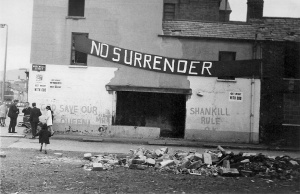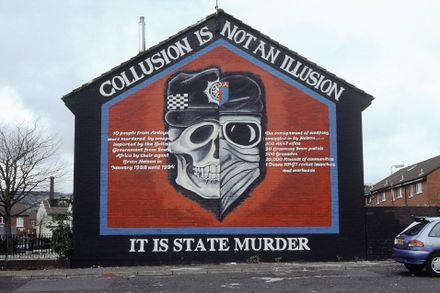Difference between revisions of "The Troubles"
(desc) |
|||
| (16 intermediate revisions by 3 users not shown) | |||
| Line 1: | Line 1: | ||
| − | {{ | + | {{event |
| − | + | |wikipedia=https://en.wikipedia.org/wiki/The_Troubles | |
| + | |start=1966 | ||
| + | |end=1998 | ||
| + | |description=The sectarian conflict in [[Northern Ireland]] which flared into serious sustained violence through the summer of 1969 | ||
| + | |image=The Troubles.jpg | ||
| + | |image_caption=Loyalist banner and graffiti on a building in the Shankill area of Belfast, 1970 | ||
| + | |constitutes=civil unrest | ||
| + | |location=Northern Ireland | ||
| + | }} | ||
| + | '''The Troubles''', a colloquialism widely used in the UK and Ireland, refer to the sectarian conflict in [[Northern Ireland]] which flared into serious sustained violence through the summer of 1969 following a Civil Rights March from Belfast to Derry in January of that year. | ||
| − | The march was | + | ==1969 Civil Rights March== |
| + | The march was one of a series of protests aimed at the injustice of gross entrenched discrimination against the Catholic (largely Nationalist/Republican sympathising) population over voting rights, housing, and employment. | ||
| − | The | + | The march was ambushed and attacked with considerable violence by a determined, organised Protestant mob led by one [[Ronald Bunting]] at Burntollet Bridge, about 5 miles from its planned destination. The [[RUC]] were accused, with considerable justification, of doing nothing to prevent the attack and of standing by whilst it was in progress. There were also credible allegations that many of the attackers were serving members of the [[Ulster Special Constabulary]] (USC) - known colloquially as the 'B-Specials'. |
| − | |||
| − | |||
| − | |||
| + | ==Wikipedia is creditable== | ||
| + | The Wikipedia articles on Northern Ireland, together with their reference sources and links, are an unusually solid and comprehensive introduction to the title of this article. There are a lot of them. | ||
| − | + | =="War on Terror"== | |
| + | [[Tom Secker]] has referred to The Troubles as "in many ways... the operational prototype for the modern [[War on Terror]]".<ref name=di12>http://www.spyculture.com/disinfowars-12-the-troubles/</ref> | ||
| + | ==State/Terrorist Collusion== | ||
| + | [[image:collusion_is_not_an_illusion.jpg|440px|left|A mural about collusion between the UK government and terrorist forces]] | ||
| + | The troubles, and just who was behind which attacks and why, remain a confusing picture as of 2016. Attackers sometimes worked together with balaclavas so as to avoid revealing their true identities even to collaborators. A podcast by [[Tom Secker]] states that terrorist groups were heavily infiltrated and that the [[establishment]] did sanction various atrocities, although their [[deep political]] purposes for this remain unclear.<ref name=di12/> | ||
| − | [ | + | ==See Also== |
| + | *[http://en.wikipedia.org/wiki/1969_Northern_Ireland_riots 1969 Wikipedia on Northern Ireland riots] | ||
| + | {{SMWDocs}} | ||
Latest revision as of 15:24, 28 December 2020
 Loyalist banner and graffiti on a building in the Shankill area of Belfast, 1970 | |
| Date | 1966 - 1998 |
|---|---|
| Interest of | Frank Kitson |
| Description | The sectarian conflict in Northern Ireland which flared into serious sustained violence through the summer of 1969 |
The Troubles, a colloquialism widely used in the UK and Ireland, refer to the sectarian conflict in Northern Ireland which flared into serious sustained violence through the summer of 1969 following a Civil Rights March from Belfast to Derry in January of that year.
Contents
1969 Civil Rights March
The march was one of a series of protests aimed at the injustice of gross entrenched discrimination against the Catholic (largely Nationalist/Republican sympathising) population over voting rights, housing, and employment.
The march was ambushed and attacked with considerable violence by a determined, organised Protestant mob led by one Ronald Bunting at Burntollet Bridge, about 5 miles from its planned destination. The RUC were accused, with considerable justification, of doing nothing to prevent the attack and of standing by whilst it was in progress. There were also credible allegations that many of the attackers were serving members of the Ulster Special Constabulary (USC) - known colloquially as the 'B-Specials'.
Wikipedia is creditable
The Wikipedia articles on Northern Ireland, together with their reference sources and links, are an unusually solid and comprehensive introduction to the title of this article. There are a lot of them.
"War on Terror"
Tom Secker has referred to The Troubles as "in many ways... the operational prototype for the modern War on Terror".[1]
State/Terrorist Collusion
The troubles, and just who was behind which attacks and why, remain a confusing picture as of 2016. Attackers sometimes worked together with balaclavas so as to avoid revealing their true identities even to collaborators. A podcast by Tom Secker states that terrorist groups were heavily infiltrated and that the establishment did sanction various atrocities, although their deep political purposes for this remain unclear.[1]
See Also
An example
| Page name | Description |
|---|---|
| Bloody Sunday (1972) | A shooting of unarmed civil rights protesters and bystanders by the British Army. |
Related Documents
| Title | Type | Publication date | Author(s) | Description |
|---|---|---|---|---|
| Document:Is Martin McGuinness a British Agent? | article | 6 February 2006 | Brian Nugent | |
| Document:John Weir Affidavit | affidavit | 3 January 1999 | John Weir | |
| Document:The Brutal Legacy of Bloody Sunday is a Powerful Warning to Those Hoping to Save Brexit | Article | 19 March 2019 | Patrick Cockburn | What we are seeing is the two most divisive issues in modern British history coming together in a toxic blend: these are Brexit and the Irish question. |
